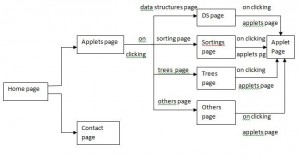Data Structures Project for Students Introduction:
Data structures play a very important role in programming. They provide the mechanism of storing the data in different ways. This optimizes searching and memory usage.
Data structures play a central role in modern computer science. They enable an efficient storage of data for an easy access. They enable us to represent the inherent relationship of the data in the real world. It enables an efficient processing of data. They help in data protection and management.
Hence it is very important for students to learn about these data structures in order to learn the programming concepts. But through theoretical knowledge, one cannot get a complete idea of these concepts. So in order to help them, we have developed a system
That visualizes various programming concepts using java applets. Those applets visualize all the inherent mechanism of all those concepts.
Although there exists many forms of visualizations, we have chosen java applets because of various benefits they offer.
http://www.youtube.com/watch?v=KSOXZQFewTc&feature=youtu.be
The features of all the java applets developed are:
- STACK: The operations like push, pop, top of the stack, is empty, is full are performed on the stack.
- QUEUE: The operations like insertion, deletion, rear of the queue, front of the queue, is empty, is full are performed on the queue.
- CIRCULAR QUEUE: The operations like insertion, deletion, rear of the queue, front of the queue, is empty, is full are performed on the circular queue.
- SINGLY LINKED LIST: The operations like insertion, deletion and search operations are performed on the singly linked list.
- DOUBLY LINKED LIST: The operations like insertion, deletion and search operations are performed on the doubly linked list.
- BUBBLE SORT: Various numbers are sorted in ascending order according to the bubble sort technique.
- INSERTION SORT: Various numbers are sorted in ascending order according to the insertion sort technique.
- SELECTION SORT: Various numbers are sorted in ascending order according to the selection sort technique.
- LINEAR SEARCH: A list of elements are created and the required value is searched in the list based on the linear search strategy.
- BINARY SEARCH: A list of elements are created and the required value is searched in the list based on the binary search strategy.
- BINARY SEARCH TREE: Operations insertion, deletion are performed on the binary search tree. Also the search operation is performed on the tree.
- TREE TRAVERSAL: A tree is created and the operations infix, prefix, postfix are performed on the tree.
- GRAPH TRAVERSAL: A graph is created and the operations BFS,DFS are performed on the graph.
- DIJKSTRA’S ALGORITHM: A graph is created and the shortest path from start node to each node in the graph is determined.
- PRIM’S ALGORITHM: A graph is created and the minimum spanning tree is determined according to the prim’s algorithm.
- KRUSKAL’S ALGORITHM: A graph is created and the minimum spanning tree is determined according to the kruskal’s algorithm.
- AVL TREE: Operations insertion, deletion are performed on the AVL tree. Also the search operation is performed on the tree.
- NQUEENS PROBLEM: A board of n*n dimension is created and the solution to the nqueens board is displayed. Also the solution is animated at each step.
- DFA: The required graph is created, and we check whether the given input string is accepted or rejected by the DFA.
- NFA: The required graph is created, and we check whether the given input string is accepted or rejected by the NFA.
- BINARY ADDITION: Two decimal numbers are accepted as input and are automatically converted into binary numbers and are added. At each step, the results are displayed.
- PROCESS SCHEDULING: Various processes and their execution times are taken as input, and they are scheduled according to the selected strategy(FCFS,SJF,ROUND-ROBIN).
- TRAVELLING SALES PERSON PROBLEM: The number of cities to be traversed are taken as input and the path through which the traveler need to traverse is determined both at a time and step by step.
- LINEAR HASHING: The hash table is created for required number of elements and insertion, deletion and search operations are performed on it.


how can i download this?
Please send me source code of this project
i want to download this